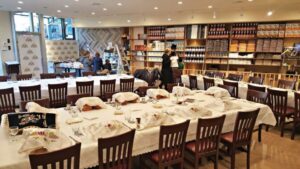Forward: How I Hosted Shabbat in a Soup Kitchen
Posted on: January 19, 2017
Courtesy of Masbia Soup Kitchen Network: Masbia Soup Kitchen Network’s new Boro Park location, set up for Shabbat.
On Friday noon, my kids — who came straight from school — and I began making the rounds to all the local Boro Park shops to prepare for Shabbos meals at Masbia Soup Kitchen Network’s new Boro Park location, where my family and I joined clients for dinner Friday night and lunch on Saturday. We are lucky because our site happens to be right in the center of Boro Park’s “Shabbos District” — if you would allow me to coin the term — right by the 55th Street station of the D train. So we have everything we need at our fingertips.
We picked up challahs from Shlomie’s Kosher Bakery, flowers from Kineret Florist and fresh tablecloths from Barnett Cleaners, groceries from Mega 53 and Bingo and wines from Moshke’s Spirits. Most of the Shabbos foods — kugels, deli and dips — we picked up from Luzee’s and we rounded it out with foods from Meisner and Dips.
Shabbos meals are all about traditional foods and foods based on minhagim (accepted tradition). To some, a Shabbos meal is vegetarian and to others it’s all about a beefy cholent. Having a public Shabbos in Boro Park, where there is a very diverse group of Jews, means the varieties are endless and I try to make sure to have something for everyone. The end result is a lavish meal where everyone feels at home.
Back at Masbia, my kids and I arranged one very large table, so that everyone could sit together for the meal. For now one large table is enough to seat all the guests, though as the numbers grow we can set up differently to accommodate more. We set the table with tablecloths and Carmona dishes and all the Shabbos accessories, so that guests could feel like they were coming to eat at someone’s house. Many of our donors donated challah covers, bread knives, white tablecloths, kiddush cups and all kinds of other Shabbos ritual meal accessories from our Amazon wishlist. Setting the food from the hot plates to the crockpots is an art in itself and we need to tweak the settings each week based on the previous week’s results.
Last Saturday was Shabbos Vayechi (meaning that the torah portion we focused on was Vayechi.) It was the first Shabbos that we advertised that we are open for guests and it was very successful. Just to give you an idea of the mix of people, there was a middle-aged local Boro Park woman who had an electrical malfunction who came because she had no hot cholent for the morning; a convert from Peru; and a Rosh Yeshiva (Yeshiva dean) from Jerusalem along with many locals.
We started the zmirot (hymns) before Kiddush two hours after candle lighting, we sang and danced for roughly 30 minutes waiting for everybody to show up. Meanwhile, my kids and one waiter started to fill the table with all kinds of Shabbos delicacies. We all did the Kiddush ritual and then washed and sat down for the meal. My wife, my seven children (ages 3–17) and I brought the food to the table like we do in our own home and started traditional songs, with my sons sometimes singing solos. Two hours in, we did birkat hamazon (the Grace After Meals) and for those who wanted to stay, we cleaned up the table and served oneg Shabbat(Joy of Shabbat — a celebration with singing, dessert and conversation) and did more singing.)
The Shabbos morning meal we start by having what’s called a traditional Kiddush, a meal of herring and kugel, and after lounging around for a while we washed for a meal at around 12:30. We had even more guests in the morning. It seems like Friday night is easier to find somewhere to go, or easier to prepare when you live alone, or it may be entirely coincidental. It’s too early to tell.
I don’t like to officially say Divrei Torah (talks based on the week’s torah portion), but I always manage to weave it in, in a causal, conversational way. For a quick tip of what I mentioned this week, I tried to explain the blessing “You shall multiply like the sand on the beach,” with an NPR story that explained the difference between sand on the beach and sand on the desert. I have always wondered why the blessing uses a sliver of sand on the beaches rather than the vast desert sand? The NPR story explains that desert sand lacks the binding quality that you find in sand by the water, so my informal D’var Torah (singular of Divrei Torah) suggested that it’s in our DNA to be able to bind together and that’s why the blessing refers to the sand by the sea rather than the sand in the desert.
We are very excited about being able to offer Shabbos meals at Masbia of Boro Park. As you can imagine it is a huge help for so many, but it is a huge financial undertaking. We have an existing Amazon wishlist with needed items at our Boro Park site, and we also have a Masbia of Boro Park Donate page where you can donate and help sponsor meals. While sponsoring an entire shabbos costs $1,800, every little bit helps.
Read the original article HERE




